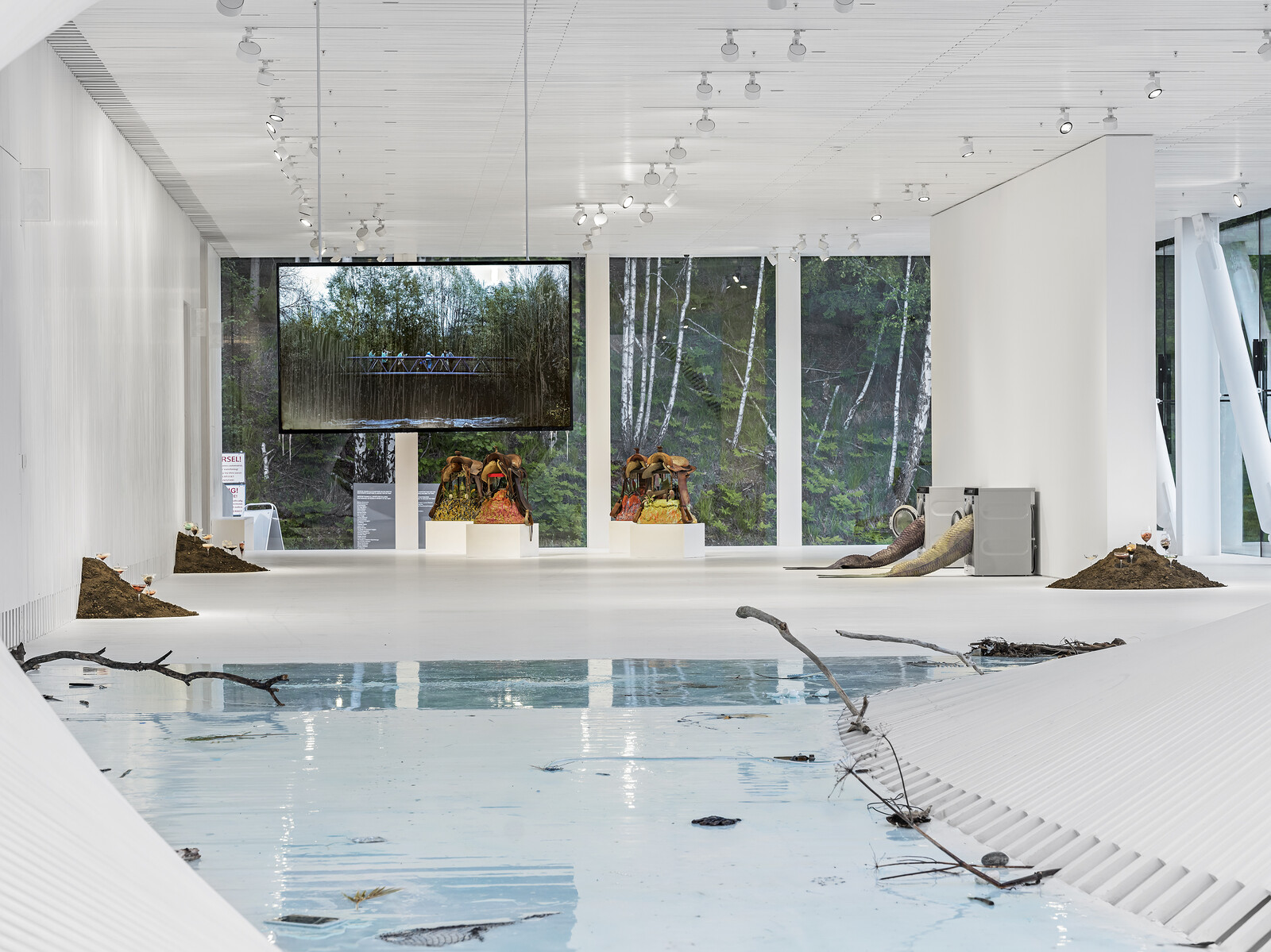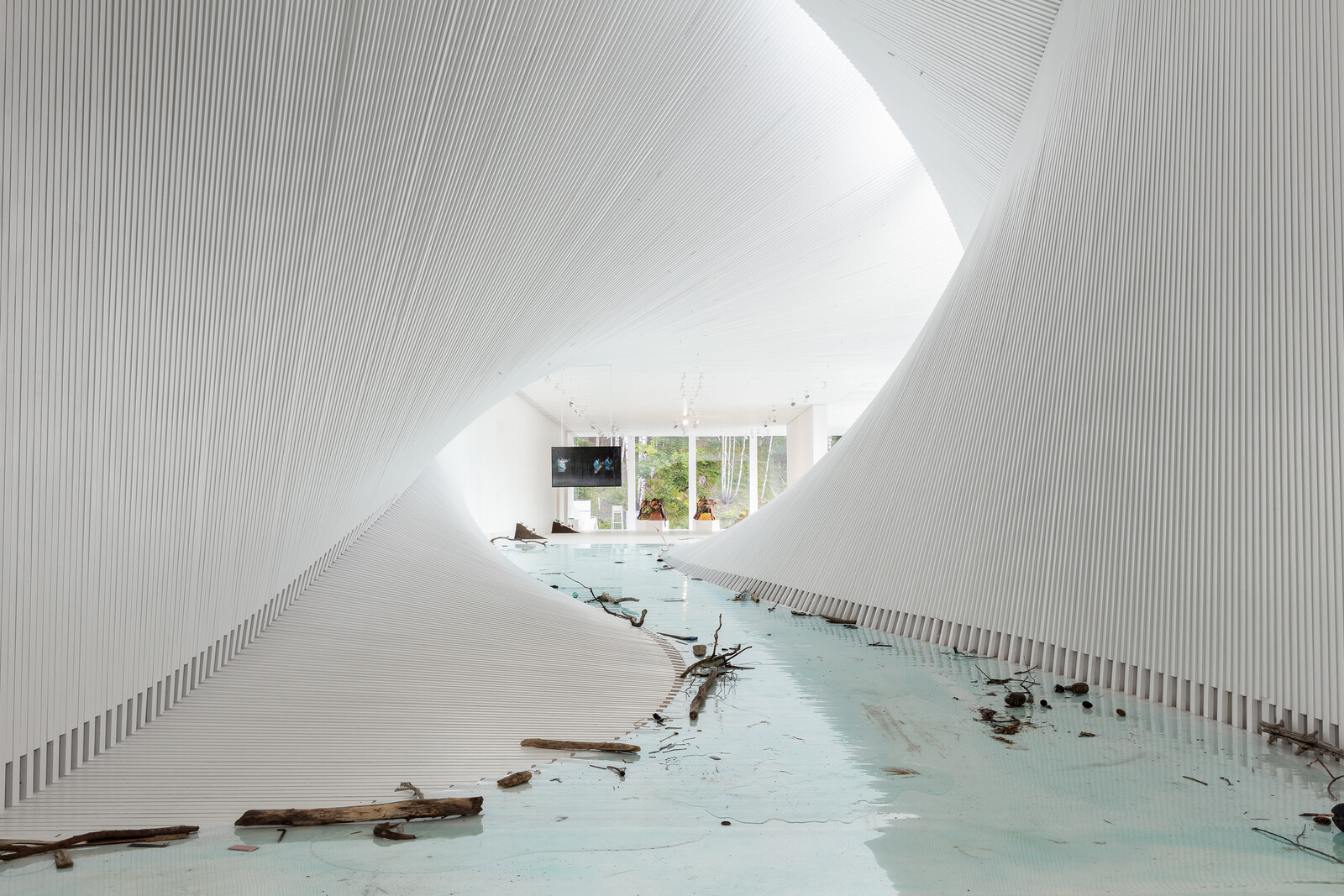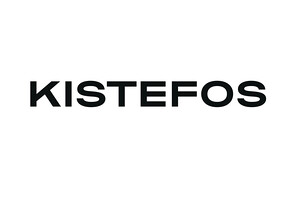May 23–October 17, 2021
Artists: Olivia Erlanger, Cécile B. Evans, Ane Graff, Pierre Huyghe, Sandra Mujinga, Laure Prouvost, Max Hooper Schneider, Soundscape by Samson
Liquid Life is a group exhibition presenting the works of seven international visual artists—among which five are new commissions—a collaborative sound piece and a series of music and dance performances, all inspired by a reflection on the relationship between humans and nature through postmodern ecology, eco-feminism and biology. The exhibition is rooted in the expression of “liquid modernity,” coined by the Polish sociologist Zygmunt Bauman to define a postmodern world governed by immediacy and communication, which erodes the anchored ties between people and bodies by revealing the fragility of a society based on individualism and constant change.
Presented inside the Twist and in its outdoor surroundings, the exhibition connects the hypermodern architecture of the building to its natural environment in the mystical Norwegian woods that envelop it, highlighting the tangled relationship between nature and humankind and interrogating our ability to co-exist and evolve together.
Welcoming the visitors like a gate-keeper or a troubling sentinel leaning against the wall, Sandra Mujinga’s corner tent-like sculpture evokes a spectral presence while assuming the role of architectural hiding places. It is a phantom that haunts us, perhaps a survivor in the post-apocalypse or a lingering specter of environmental destruction. The installation is enhanced by a green light that recalls a green screen and immerses the viewer into an environment that feels like a nightclub or a travel dystopia. Inspired by the world-building practices found within video games, science-fiction novels and Afrofuturism, the artist invites us to enter an ephemeral and ethereal world.
Cécile B Evans’ for A Future Adaptation of Giselle (Willis’ battle of whatever forever) is a three-channel film installation that is part of an ongoing adaptation of the classical Industrial era ballet Giselle, co-produced with Ballet National de Marseille / (LA)Horde. The work is anchored in the struggles of a family as they try to adapt Giselle into a revolutionary eco-feminist thriller while the modern world is collapsing and focuses on the development of a crucial, dramatic moment: the battle scene. The director, an animated rubber plant, grapples with the structural shortfalls of their own process as the boundaries of the different realities they inhabit are pierced and begin to intertwine. Installed in several stages for the duration of the exhibition, for A Future (…) extends its internal themes of multiplicity and mutation outwards to visitors.
Further inside the Twist and inspired by her liquid and tentacular project for the French Pavilion of the 58th Venice Biennale, Laure Prouvost’s installation conveys the attention she gives to the natural and human elements that surround her, calling to mind the immersive quality of her films, installations, objects and drawings. The artist has coated the floor of the Twist with bluish resin, ornamenting its surface with shattered technological junk, glass objects and found material from around the Museum. This river of resin culminates with the screening of an excerpt of They Parlaient Idéale (2019), in which a group of travelers joyfully dance to a brass band in the delirious architecture of Palais Idéal du Facteur Cheval.
Overlooking the river, Pierre Huyghe’s work is an output from his project UUmwelt, conceived as a co-production of imagination between a human and a machine using a brain-computer interface. During the process, a set of elementary components were given as images or descriptions to be imagined by a subject, among which biological entities, prehistoric tools, machines, codes and artworks. While the person imagined these components, their brain activity was captured by an fMRI scanner and reconstructed by a deep neural network. As a result, the work is a mental image that has been turned into a physical object and composed of an aggregate of synthetic and biological materials and micro-organisms set to modify according to its environment and, ultimately, erode with time.
In her installation titled Ida !!! Olivia Erlanger exhibits a series of silicon life-size mermaid tales hanging from the open doors of washing machines. The chimeric surrealism of these mythical creatures seems to wittily contrast with the raw functionality of the washers, echoing the industrial site of Kistefos and its dialogue with the magical woods that surround it. Here a fictional character from a Norvegian folk tale seems to have invaded the realness of the exhibition space, figuring in many ways the contemporary re-harnessing of the surrealist ideal of the “marvelous”, a notion pledged to the re-enchantment of a disenchanted world, this of a capitalist society made cruelly rational.
Fascinated by the human body as a place of encounters where microbiology, materials and personal stories convene, Ane Graff has disseminated three series of goblets containing an assemblage of materials — medications, consumer goods, food, cosmetics, historical pigments, soil, fertilizer, salts, metals, sea shells and minerals. Considering the relationship between synthetic biology and biomedical engineering, the work has been empowered by a collaboration with New York-based scientist Tal Danino, thanks to whom the artist was able to add bacterial cultures and pigments to some of her sculptures. Acting as a living invasion of the exhibition space by a local flora, Graff’s installation also reflects on our relationship to bacteria, microbiome and viruses.
Max Hooper Schneider’s work in the exhibition will, over the course of a month-long residency, hybridize and revision elements fabricated inside his Los Angeles studio—shrine-like desert assemblages, a scavenged freeway sign, an aluminum cast of a demolished treadmill—with autochthonous site materials and regional workflows. Research on water and fire power, forest biota, holographic projection, folklores past and present, and histories of manufactured landscapes, will materialize a logic that is manifest across a suite of neon apparitions, fiery fountains, parasitic signage and glass integuments. The resultant installation will attest to the artist’s interpretation of ecological myth-making as founded in the conditions presented by a unique temporal and spatial ordering that remains in flux.
Figuring the introduction and the conclusion to the exhibition, a collaborative soundscape work, composed and produced under the direction of Paris-based electronic musician and producer Samson, greets the visitors in the woods, leads them into the exhibition space and accompanies them as they walk outside of the Twist. Inspired by liquidity, Norwegian folk culture and the sonic surroundings of the Museum, and imagined as a collaborative effort, this 40-minute-long experimental piece brings together diverse styles of music —spiritual jazz, cosmic pop, spoken word, ambient and sounds— performed and recorded by a group of international musicians including Nils Bech, Clémentine Billy, Chouf, Daniel Clarke, Carel Cléril, John D’Earth, Julian Garcia, Robby Sinclair, Anna Majidson, Tez, Audun Waage.
The exhibition was made possible thanks to the generous support of Kistefos AS, Ballet National de Marseille/(LA)Horde.





